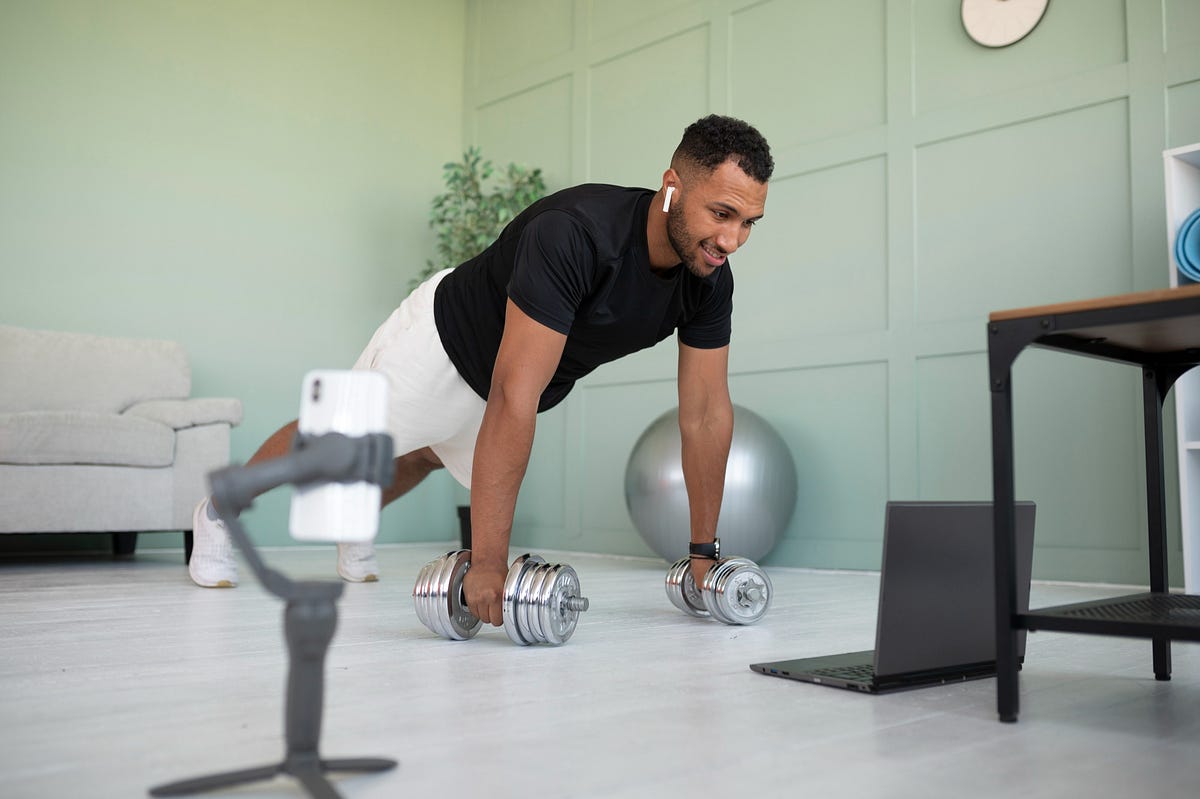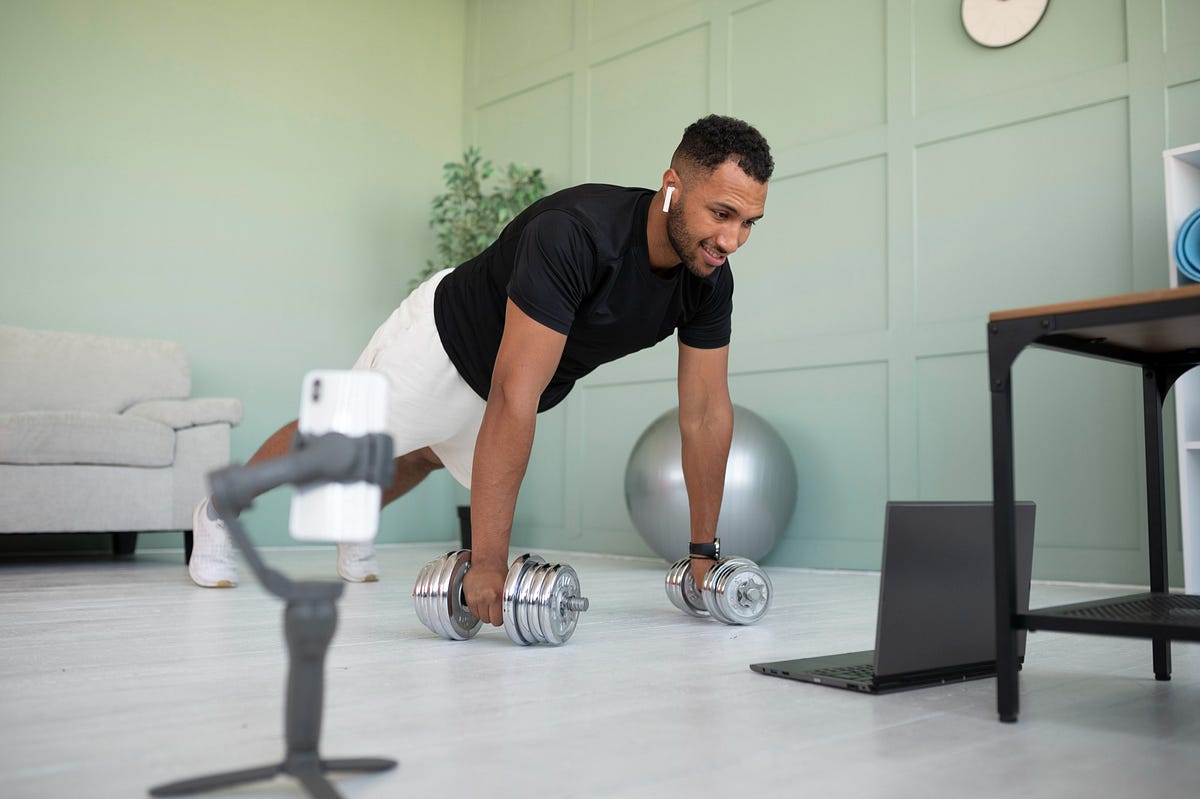Strength and muscle building program for busy professionals? Sounds like an oxymoron, right? Think again! This isn’t about becoming the next Mr. Olympia; it’s about sculpting a stronger, healthier you amidst the whirlwind of deadlines and conference calls. We’re ditching the hour-long gym sessions and embracing efficient, effective workouts that fit into even the most jam-packed schedules.
Get ready to unlock your inner superhero, one power-packed workout at a time.
This guide is your secret weapon against the tyranny of the to-do list. We’ll navigate the treacherous terrain of time constraints, crafting personalized workout plans that are as flexible as you are. From 30-minute full-body blasts to bodyweight-only routines perfect for travel, we’ve got you covered. We’ll also tackle the nutrition side of things, providing delicious and convenient meal prep ideas that fuel your gains without sacrificing your sanity.
Prepare to conquer your fitness goals without sacrificing your career (or your sleep!).
Understanding Time Constraints for Busy Professionals
Let’s face it, the life of a busy professional often resembles a high-speed chase scene from a Hollywood blockbuster – except instead of a getaway car, it’s a overflowing inbox, and instead of a pursuing police force, it’s a mountain of deadlines. Juggling work, family, social life, and maybe even a side hustle feels like trying to solve a Rubik’s Cube while riding a unicycle.
But fear not, fellow time-challenged titan! We’re here to help you conquer your schedule and sculpt the physique of your dreams.The typical daily schedule of a busy professional is a whirlwind of meetings, emails, presentations, and the ever-present pressure to perform. Picture this: a 7 AM wake-up call, followed by a quick breakfast (if you’re lucky), a commute battling rush hour traffic, a jam-packed workday filled with back-to-back appointments, then the evening rush of dinner, family time, and maybe squeezing in a few more work emails before collapsing into bed.
Sound familiar? We thought so.
Common Time-Management Challenges Faced by Busy Professionals
Busy professionals often struggle with prioritizing tasks, effectively delegating responsibilities, and saying “no” to commitments that drain their energy and time. Procrastination, inefficient scheduling, and a lack of clear goals can also significantly impact their ability to manage their time effectively. The constant barrage of notifications and the pressure to be “always on” further exacerbate these challenges, creating a vicious cycle of stress and overwhelm.
Many professionals find themselves constantly reacting to urgent requests rather than proactively managing their time and focusing on what truly matters.
Integrating a Strength and Muscle Building Program into a Busy Schedule
The key to successfully incorporating a workout routine is to treat it like any other important appointment – schedule it in! This isn’t about finding massive blocks of free time; it’s about strategically using the smaller pockets of time you already have. Think of it as assembling a workout mosaic from the spare tiles in your day. Instead of aiming for hour-long gym sessions, consider shorter, more intense workouts.
High-intensity interval training (HIIT) is a great option, allowing you to achieve significant results in a fraction of the time.
Examples of Time-Blocking Strategies for Workout Routines
Before outlining specific strategies, it’s important to remember that consistency is key. Finding a routine that fits your lifestyle and sticking to it is more effective than sporadic, intense bursts of activity.The following are some examples of time-blocking strategies:
- Early Morning Workout: Wake up 30-45 minutes earlier than usual for a quick bodyweight circuit or a brisk run. This gets your workout done before the day’s demands begin to pile up.
- Lunch Break Blitz: Use your lunch break for a fast-paced workout at your office gym or a nearby park. Even a 20-minute session is better than nothing.
- Evening Express Workout: Dedicate 30-45 minutes after work to a home workout, using minimal equipment. This allows for a focused session before winding down for the evening.
- Weekend Warrior: If your weekday schedule is truly packed, dedicate a longer workout session on the weekend to make up for shorter weekday workouts. This provides flexibility and prevents burnout.
Remember, even small chunks of time add up. A 15-minute walk during your lunch break, a set of push-ups before bed – every little bit helps in building a healthier, stronger you. Don’t aim for perfection; aim for progress. And remember, a slightly sore body is a sign you’re doing something right!
Efficient Workout Routines
Let’s face it, busy professionals don’t have time for epic sagas in the gym. We need efficient, effective workouts that deliver results without demanding a lifetime commitment. Think of these routines as your superhero training montage, condensed into the time it takes to watch a single episode of your favorite show.These sample routines are designed for varying time constraints and fitness levels.
Remember to consult your doctor before starting any new workout program. Safety first, gains second (but gains are pretty important too!).
30-Minute Full-Body Strength Training Workout
This workout is perfect for those short on time but big on ambition. It targets all major muscle groups, ensuring a balanced and effective full-body workout. The key is to move quickly between exercises, minimizing rest time to maximize calorie burn and muscle engagement. Think of it as high-intensity interval training (HIIT) for strength building.
| Exercise | Sets | Reps | Rest |
|---|---|---|---|
| Squats | 3 | 10-12 | 30 seconds |
| Push-ups | 3 | As many as possible (AMRAP) | 30 seconds |
| Rows (using dumbbells or resistance bands) | 3 | 10-12 | 30 seconds |
| Lunges (alternating legs) | 3 | 10-12 per leg | 30 seconds |
| Plank | 3 | 30-60 seconds | 30 seconds |
45-Minute Upper/Lower Split Workout Routine
For those with a little more time to dedicate, this split routine allows for deeper muscle engagement. By focusing on either the upper or lower body each session, you can increase the intensity and volume without overtraining. Think of this as a more targeted approach, ensuring every muscle group gets its due attention.
| Exercise | Sets | Reps | Rest |
|---|---|---|---|
| Bench Press (or Push-ups) | 3 | 8-12 | 60 seconds |
| Overhead Press (or Pike Push-ups) | 3 | 8-12 | 60 seconds |
| Bicep Curls | 3 | 10-15 | 60 seconds |
| Triceps Extensions | 3 | 10-15 | 60 seconds |
| Squats | 3 | 12-15 | 60 seconds |
| Deadlifts (Romanian or conventional) | 3 | 8-12 | 60 seconds |
| Calf Raises | 3 | 15-20 | 60 seconds |
Bodyweight Workout Routine
No gym? No problem! This routine uses only your bodyweight for resistance, making it perfect for home workouts or travel. Think of it as the ultimate portable gym – your own body is the equipment.
| Exercise | Sets | Reps | Rest |
|---|---|---|---|
| Squats | 3 | 15-20 | 45 seconds |
| Push-ups | 3 | AMRAP | 45 seconds |
| Lunges (alternating legs) | 3 | 10-12 per leg | 45 seconds |
| Plank | 3 | 30-60 seconds | 45 seconds |
| Burpees | 3 | 10-12 | 45 seconds |
| Crunches | 3 | 15-20 | 45 seconds |
Nutrition for Muscle Growth and Busy Schedules

Let’s face it, juggling a demanding career and a serious commitment to building muscle is like trying to solve a Rubik’s Cube while riding a unicycle – challenging, but definitely achievable with the right strategy! Forget the myth that you need hours in the kitchen to fuel your gains. This section focuses on smart, efficient nutrition for the time-constrained professional who wants to see real results.Meal prepping isn’t about slaving away for hours on Sunday; it’s about strategic planning to maximize your time and minimize your stress.
Think of it as an investment in your future physique – a future where you’re not constantly scrambling for healthy options.
Meal Prep Strategies for Busy Professionals
Smart meal prepping for muscle growth revolves around preparing components in advance, rather than entire meals. This allows for quick assembly and variety throughout the week. For example, cook a large batch of quinoa or brown rice on Sunday. Roast a tray of chicken breast and vegetables (broccoli, peppers, sweet potatoes – get creative!). Prepare a large container of hard-boiled eggs.
Now, throughout the week, you can quickly assemble meals by combining these components in different ways. One day it might be chicken and quinoa with roasted vegetables; another day, it could be a salad with chicken, hard-boiled eggs, and a light vinaigrette.
Examples of Quick and Nutritious Pre and Post-Workout Meals
Pre-workout, you need something easily digestible that provides sustained energy. A small bowl of oatmeal with berries and a scoop of protein powder is a perfect example. Alternatively, a banana with a handful of almonds provides a quick burst of carbs and healthy fats. Post-workout, your muscles are screaming for protein and carbohydrates to repair and rebuild.
A protein shake with added banana or a Greek yogurt parfait with granola fits the bill perfectly. Think about the ratio of carbs to protein, leaning more toward carbs pre-workout and protein post-workout.
The Importance of Protein Intake for Muscle Growth and Recovery
Protein is the undisputed king of muscle building. It provides the amino acids your body needs to synthesize new muscle tissue and repair damaged fibers after intense workouts. Aim for a daily protein intake of approximately 1 gram per pound of body weight. This can be achieved through a combination of lean meats (chicken, turkey, fish), eggs, dairy products (Greek yogurt, cottage cheese), legumes, and protein powder.
Don’t be afraid to experiment to find protein sources you enjoy and can easily incorporate into your busy schedule.
The Role of Hydration in Strength Training and Overall Health, Strength and muscle building program for busy professionals
Hydration is often overlooked, but it’s crucial for optimal performance and recovery. Dehydration can lead to fatigue, muscle cramps, and reduced strength. Aim to drink plenty of water throughout the day, especially before, during, and after your workouts. A good rule of thumb is to drink half your body weight in ounces of water daily. For example, a 150-pound person should aim for 75 ounces of water per day.
Electrolyte drinks can be beneficial during longer or more intense workouts to replenish lost electrolytes. Remember, staying hydrated is as important as lifting those weights!
Home Workout Equipment and Alternatives
Let’s face it, busy professionals don’t have time for elaborate gym memberships and hour-long commutes. Building a strong, muscular physique is entirely possible even if your schedule resembles a game of Tetris. The key lies in smart choices regarding equipment and efficient workout strategies. This section will explore the best ways to equip your home gym – or even better, your living room – for maximum muscle-building impact.The age-old debate: home gym equipment versus bodyweight training.
Both have their strengths (and, let’s be honest, their quirks). A home gym offers more variety and the potential for heavier weights, leading to faster strength gains. Bodyweight training, however, is incredibly accessible, requiring zero equipment and offering a fantastic cardiovascular workout as a bonus. The best approach often involves a smart combination of both.
Juggling spreadsheets and biceps? Yeah, we get it. Finding a strength and muscle building program for busy professionals can feel like searching for the Holy Grail. But fear not, stressed-out superhero! Check out the best strength training program for time-crunched individuals – it’ll help you sculpt those muscles without sacrificing your sanity (or your sleep!).
Then get back to conquering your to-do list, one perfectly sculpted rep at a time.
Home Gym Equipment Essentials
Investing in a few key pieces of equipment can significantly enhance your home workout experience. The goal is to select versatile tools that allow for a comprehensive strength training program without cluttering your living space.
- Adjustable Dumbbells: These are space-savers that replace a whole rack of fixed-weight dumbbells. Imagine a set that goes from 5 pounds to 50 pounds – that’s a huge range of exercises covered in a relatively compact package. Think of the satisfying
-clink* as you adjust the weight between sets. - Resistance Bands: These are surprisingly effective for a variety of exercises, from bicep curls to squats. Their portability is unmatched – you can even sneak in a quick workout during your lunch break in the office (don’t tell your boss!).
- Pull-up Bar: This is a classic for a reason. Pull-ups are a fantastic compound exercise, working multiple muscle groups simultaneously. Even if you can only manage a few, the benefit is significant. Consider a doorway pull-up bar for space-saving convenience.
- Workout Bench: An adjustable bench allows for a wider range of exercises, including bench presses, incline presses, and various core exercises. While not strictly essential, it greatly expands your workout possibilities.
Effective Bodyweight Exercises
Bodyweight training is a powerhouse of muscle-building potential, requiring no equipment whatsoever. The key is to focus on proper form and progressive overload (gradually increasing the difficulty of the exercise).
- Push-ups: A classic for a reason! Vary hand placement to target different muscle groups.
- Squats: The king of leg exercises. Focus on proper form to avoid injury.
- Lunges: Excellent for leg and core strength. Try variations like walking lunges or reverse lunges.
- Plank: A fantastic core exercise that improves stability and strength.
- Burpees: A full-body exercise that combines cardio and strength training – a great way to elevate your heart rate and build muscle.
Affordable Home Workout Equipment Alternatives
Don’t let budget constraints derail your fitness goals. Many household items can be repurposed as surprisingly effective workout equipment.
- Filled Water Bottles or Cans: These can be used as makeshift dumbbells for lighter exercises.
- Chairs: Use a sturdy chair for dips, tricep extensions, and other exercises.
- Backpack filled with books or sandbags: A makeshift weighted vest for added resistance.
- Towels: Use towels for resistance during exercises like rows or bicep curls.
Workout Motivation and Consistency
Let’s face it, juggling a demanding career and a fitness regime is like trying to herd cats while riding a unicycle – challenging, but not impossible! The key to success lies in understanding that consistency, not intensity, is the secret weapon in your muscle-building arsenal. Forget about unrealistic expectations; instead, focus on building sustainable habits that fit seamlessly into your already packed schedule.Staying motivated and consistent with a strength training program requires a strategic approach.
It’s not about becoming a superhuman overnight, but about making small, incremental changes that compound over time. Think of it as building a skyscraper, one brick at a time. Ignoring the foundations (consistent effort) will lead to a wobbly, eventually collapsing structure.
Setting Realistic Fitness Goals
Setting realistic goals is crucial for long-term success. Instead of aiming for a bodybuilder physique in three months (unless you’re genetically gifted and have 24/7 access to a personal chef and trainer), focus on achievable milestones. For example, instead of aiming to lift 200 pounds, start with a weight you can comfortably manage and gradually increase it. Celebrate every small victory, no matter how insignificant it may seem.
Consistency trumps intensity, remember? Progress, not perfection, is the name of the game.
Strategies for Maintaining Motivation and Consistency
Maintaining motivation and consistency involves a multi-pronged approach. First, find an exercise you genuinely enjoy. If you hate running, don’t force yourself to run! Explore different activities until you find something that sparks your interest. This could be anything from yoga to weightlifting to dancing. Second, schedule your workouts like any other important appointment.
Treat them as non-negotiable. Third, find a workout buddy. Having someone to hold you accountable can make a world of difference. Fourth, reward yourself for reaching milestones, but make sure the rewards align with your goals (a healthy smoothie, not a whole pizza!). Finally, don’t be afraid to adjust your routine as needed.
Life happens, and sometimes you’ll need to reschedule or modify your workout. Flexibility is key.
The Benefits of Progress Tracking and Achievement Celebration
Tracking your progress is like having a personal cheerleader. Seeing your improvement, even in small increments, provides a powerful motivational boost. This can be done through a simple notebook, a fitness app, or even a spreadsheet. Note the weights you lift, the number of reps you complete, and how you feel. Celebrate your wins! Reaching a new personal best?
Treat yourself to something you enjoy. Did you consistently workout for a month? Give yourself a pat on the back. These small celebrations reinforce positive behavior and keep you motivated.
Creating a Positive and Supportive Fitness Community
Surrounding yourself with a supportive community can significantly boost your motivation and consistency. This could be a group of friends who exercise together, an online fitness community, or even a personal trainer. Sharing your goals and progress with others can provide encouragement and accountability. Remember, finding your tribe is vital for staying motivated. Consider joining a gym with a strong sense of community, or even starting your own online group with colleagues or friends who share similar fitness goals.
The shared experience and mutual support can make all the difference.
Workout Safety and Injury Prevention

Let’s face it, nobody wants to spend their precious time sidelined by a pulled hamstring or a tweaked back. Building a powerhouse physique is fantastic, but doing it safely is even better. This section focuses on preventing injuries so you can consistently crush your fitness goals without turning into a human pretzel. We’ll cover proper form, common injury culprits, and ways to make your workouts safer and more effective, regardless of your fitness level.
Proper Form and Techniques for Common Strength Training Exercises
Mastering proper form is paramount. Think of your body as a finely tuned machine; incorrect technique is like throwing sand in the gears. Let’s examine some common exercises and their correct execution. For example, during a squat, maintaining a neutral spine (imagine a straight line from your head to your tailbone) is critical. Your knees should track over your toes, avoiding excessive inward or outward movement.
Similarly, when bench pressing, keep your feet flat on the floor, your butt firmly on the bench, and avoid arching your back excessively. Deadlifts require a straight back, engaging your core, and lifting with your legs, not your back. A slight bend in the knees is acceptable. Incorrect form in these exercises can lead to lower back pain, knee injuries, or shoulder impingement.
Always start with lighter weights to focus on proper technique before increasing the load.
Common Injuries Associated with Strength Training and Their Prevention
Strength training, while incredibly beneficial, does carry a risk of injury. Common culprits include lower back pain (often from improper form in squats or deadlifts), rotator cuff injuries (shoulder pain from improper overhead pressing), knee injuries (often from improper squatting or lunging), and wrist pain (from improper form in exercises like push-ups or rows). Prevention involves proper warm-up, gradual progression of weight, and focusing on controlled movements.
Listen to your body; pain is a signal to stop and adjust. Consider consulting a physical therapist or certified personal trainer for personalized guidance, especially if you have pre-existing conditions.
The Importance of Warming Up and Cooling Down Before and After Workouts
Think of warming up as preparing your engine for a long drive – you wouldn’t just jump in and floor it, would you? A proper warm-up increases blood flow to your muscles, preparing them for the work ahead and reducing the risk of injury. This could include 5-10 minutes of light cardio, followed by dynamic stretches like arm circles, leg swings, and torso twists.
Cooling down is equally crucial. It helps your body gradually return to its resting state, reducing muscle soreness and stiffness. This might involve 5-10 minutes of light cardio and static stretches, holding each stretch for 20-30 seconds. Think of it as giving your muscles a gentle massage after a hard day’s work.
Modifications for Exercises to Accommodate Different Fitness Levels
Not everyone starts as a weightlifting champion. Modifications are essential to ensure everyone can participate safely and effectively. For squats, beginners might start with bodyweight squats before progressing to goblet squats (holding a weight at chest height) or barbell squats. For push-ups, beginners can perform them against a wall or on their knees, gradually progressing to standard push-ups.
Similarly, deadlifts can be modified by using lighter weights or performing Romanian deadlifts (a variation that focuses more on the hamstrings and glutes), which are generally considered less stressful on the lower back for beginners. Remember, progression is key – start where you are and gradually increase the intensity and difficulty as you get stronger.
Integrating Strength Training into Travel: Strength And Muscle Building Program For Busy Professionals

Let’s face it, the phrase “business trip” doesn’t exactly conjure images of sculpted biceps and bulging quads. But fear not, fellow fitness fanatics! Maintaining your strength training routine while traveling is entirely achievable, even if your idea of a “gym” is currently the cramped hotel bathroom. With a little planning and ingenuity, you can conquer both the boardroom and the barbell, no matter your destination.Maintaining a strength training program while traveling requires strategic planning and a willingness to embrace creative solutions.
Gone are the days of relying solely on a fully equipped gym; adaptability is key. This section will provide practical strategies and alternative workout options to ensure your fitness journey doesn’t hit a snag during your travels.
Portable Workout Equipment for Travel
Packing light is a traveler’s mantra, but that doesn’t mean sacrificing your fitness goals. Fortunately, a surprisingly effective workout can be achieved with minimal equipment. A resistance band, for instance, is a versatile tool that can be used for a full-body workout, mimicking the movements of many weight machines. Its compact size makes it perfect for slipping into a suitcase or carry-on.
Similarly, a jump rope provides a fantastic cardiovascular workout and takes up virtually no space. Finally, consider a set of lightweight dumbbells; while slightly bulkier, they offer a wider range of exercises than resistance bands alone. Remember to choose a weight appropriate for your fitness level and the type of travel you’ll be doing.
Locating Gyms and Fitness Facilities While Traveling
Finding a gym while on the road is easier than you might think. Hotel gyms, while often basic, provide a better option than nothing. Many hotel chains advertise fitness facilities on their websites. Additionally, apps like Google Maps and dedicated fitness apps can help you locate nearby gyms, including those with day passes. Before embarking on your journey, it’s wise to check online reviews to gauge the quality and equipment available at potential gyms.
Don’t hesitate to call ahead to confirm hours of operation and any associated costs.
Alternative Workout Options: Bodyweight Exercises and Hotel Gym Workouts
Let’s be honest, sometimes a fully equipped gym isn’t an option. That’s where bodyweight exercises shine! These require no equipment and can be performed virtually anywhere – your hotel room, a park, or even the airport (discreetly, of course!). Think push-ups, squats, lunges, planks, and burpees. These fundamental exercises effectively target major muscle groups and can be adapted to different fitness levels.
Even a basic hotel gym offers opportunities for strength training. Focus on compound movements like squats, bench presses (using dumbbells or the gym’s machines), and rows to maximize your workout efficiency. Remember to prioritize proper form to avoid injury.
Closure
So, there you have it – a roadmap to a stronger, healthier you, even when time seems to be your biggest opponent. Remember, consistency is key, and even small steps forward accumulate into significant progress. Celebrate those wins, adjust your strategy as needed, and never underestimate the power of a well-timed power nap (we won’t judge!). Embrace the challenge, and prepare to unleash your inner fitness ninja.
You’ve got this!
